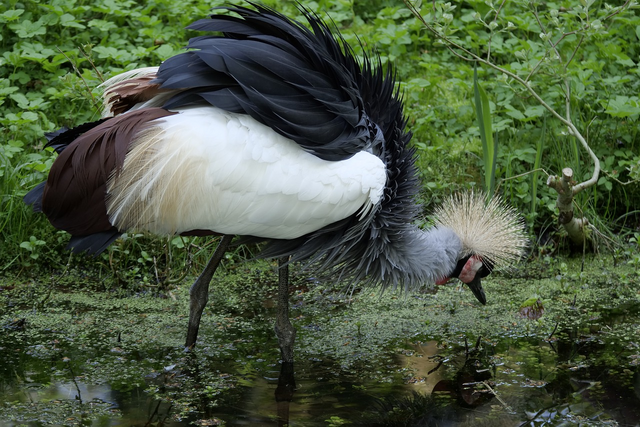Lexicon of spirit animals: crane
Mode of life:
The 15 different crane species, of which several are critically endangered, can be found on all continents except South America and Antarctica. While some species migrate over long distances, others don't migrate at all. Yet nearly all species require vast areas of open space usually in form of wetland. Distinct peculiarities of the crane are its feathered eyelashes, spindly thin legs, a long and flexible neck, and a decorative plume at the back of the head. The plumage color normally ranges from grey to brown with black wings. During breeding season cranes are very loyal with their territory, but in the non-breeding season they are rather gregarious whereby the build large flocks within which they like to roost, socialise or feed. Cranes' diet varies depending on the season; mainly however, they prefer plants, semen and fruits combined with an array of smaller animals such as rodents or amphibians. Migrating flocks of crane start heading for their winter habitat at the end of October: during their travel, executed in shape of a flying V, they reach heights of up to 4,000 meters and are able to fly days-long without a break. Depending on the weather conditions they return between February and March. Shortly after arrival mating season begins, which is being performed by pairs of cranes dancing while trumpeting clarion sounds with their guttural voices. For breeding they then withdraw from the flock and build their nest, either in shallow water or on soil, with the female usually laying two eggs per incubation. Hatchlings are precocial, leaving the nest after two days already. They stay in the vicinity, however, becoming feeded and guided by the oldest members of crane flocks. After about 10 weeks they leave their home to join new flocks. Cranes' life expectancy in the wild is 20-30 years.
 Source Source |  Source Source |
Spiritually light aspects:
Being an archetypical symbol in martial arts, the crane brings us focus, mental strength and meditation. Cranes ability to effortlessly stay on one leg without losing their equilibrium, something they either do while roosting or preening, is reflective of great balance. Therefore, connecting with the crane enhances our ability to establish a state of long-term silence in our mind to an extend that the mental relaxation we receive will also become noticeable in form of increased comfortability in our physical body. The crane has the expertise to identify clogged thought clusters and inject the necessary conscious calm into them so as to enable the thorough energetic dissipation thereof. By doing so, cranes teach us that we can choose our thoughts instead of attesting them the natural ability to unavoidably develop a life of their own. With the mental strength gained, the crane then also helps us to recognise potential mental pitfalls early on so that we can right away adjust our actions in the most health-conducive way.
 Source |  Source |
Spiritually dark aspects:
Cranes have a penchant for loftiness and can be quite rejecting. People with the crane as their spirit animal tend to take their public demeanor so seriously that they consider anyone displaying more light-hearted humor as silly fools. In a way, the crane's uptight public behavior stems from its overemphasising of mental self-control that has led to a categoric expulsion of any superfluous clutter. With its huge thirst for being taken seriously, even jokingly teasing the crane can cause its self-esteem to severely crumble, which is why they often prefer concise and rather impolitely direct, though honest, speech in the hope of not gaining center stage. Cranes have yet to learn that being able to laugh at ourselves is the best way to not be at the mercy of others' opinion.
Much Love and Light,
Alex


Thank you, the post was informative & well written.
Posted using Partiko Android